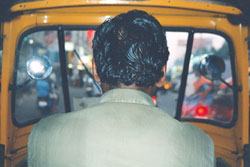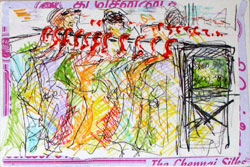India ~ Day 2
Brought to you by: 
Schlepping for saris and other mundane wonders
Primarily, Todd and I have come to India to behold – and graciously gawk at, if truth be told – the fanciful Hindu wedding of Raja, born of Indian parents who raised him in the Long Island suburbs, to Sarah, an adventurous Oregonian white girl. Since we’re also here for the food, we share a table at the hotel’s restaurant with the affianced couple and some of their friends and family who have also endured the around-the-globe trek. Together, we plod through an unfamiliar breakfast menu.
Everyone is impressed that Todd and I are not only awake, but are surprisingly spry and ready to sop something spicy. Melatonin is quite a spectacular drug at unlagging a jet-lagger’s recovery.
Sarah, never a fearless gourmand, picks the tourist-friendly egg and cornflake continental breakfast. Our first lesson: always specify cold milk for your cereal, otherwise it’s served steaming hot. I order a masala dosa, the only familiar thing on the menu. Out comes a crispy yet tender lentil and rice flour crepe, filled with a heap of spiced potatoes, yellow with turmeric, popping with mustard seeds, crunchy with onions, kicking with curry leaves. Other meals litter the table, including sweet red onion appams (another crepe-style dish) and idlis – poofy, white, spongy, sour-yet-simultaneously-bland …um, “things” – all accompanied by sweet tamarind and spicy coconut sauces. There’s fresh pineapple juice, bottled water, and hot, supahschweet chai for everyone.
Victually satisfied, a smaller group of us roll around the city in a hired car for a practical day of errand running and culture shock. To do: change money (check), buy boat and train tickets, and get some wedding-appropriate clothing. We hit up a government-run tourist office to reserve houseboats in Kerala, a coastal state in the southwest beloved for its backwaters, coconuts and Communists. With eight people to accommodate in the high honeymoon season, we are told all boats are booked – at first. Gradually, we divine that if enough chatty Americans sit and blithely compare their Lonely Planets to their Rough Guides, all the while monopolizing a small office that is normally empty except for one well-intentioned, if uninspired, travel agent, said agent will find boats enough.
We spend the next several hours scuttling about for train tickets to Kerala. Air-conditioned sleeper trains are as cheap as 1 or 2 rupees (approximately 2 to 4¢) per mile, astonishingly efficient, practically the only way to travel, run by the government, and therefore book well in advance and require more effort than should be necessary to reserve. A long line of chairs extends away from each train station ticket window, ready for a queue of butts. There’s a demonstrably impatient and impertinent man who screeches at us to move up whenever even a single chair sits empty in front of us. When we finally reach the front of the line, the clerk notifies us that we are at the wrong station for the train we want. So, across town to the proper station, to queue again in a tourist ticket office. After another wait, forms are filled, documents provided, cash paid (always cash, no one wants our plastic, especially the Indian government), tickets issued, and stamps inevitably stamped. A queue – or simply “Q” – is the way things happen – or don’t – in India.
Raja has felt a bit delinquent for insulating me, Todd and Sheri from the full-frontal India experience, so he leaves us to muddle and stumble on our own at The Chennai Silks, a multi-storied, hectic clothing store. Todd’s off to men’s formal wear, while Sheri and I head to the sari floor so we can each dud up for the wedding.

On arriving in the territory of silk, Sheri and I are ushered to a deep counter where a handful of barefoot, mustachioed men unfurl dozens of luminescent, beaded fabrics. Though literally deluged by a tall, chromatic mound of saris, we each single out a favorite and the ponderous purchasing process begins. Each chosen sari is refolded by thousand-times-iterant hands and then boxed, bagged and escorted to a counter at which we pay, our copy of the receipt is duly stamped as is another copy that is then attached to the package, and the whole is sent by dumbwaiter to the ground floor; all this so we can pick up our purchases once we’ve finished the day’s shopping (hence all the coordinated stamping).
Yet the sari is not complete; we each need a blouse, or choli, and petticoat (essentially a drawstring skirt). To purchase these basic accessories, we must leave the main store and reenter The Chennai Silks through a stigma-laden basement door. The city of Chennai is renowned within India for its cultural and religious conservativism, and this sidelining of ladies’ underthings reveals a community easily discomfited. The sleeves of the pre-fabbed choli are tight (apparently, sausaged arm fat can be a sign of feminine beauty) and the boobs wrinkly protrude with extra fabric like empty foam-domes.
Back in the main store, we find Todd laden with a bunch of nearly-neon shirts for everyday and a swank Indian suit, or shirwani: baggy drawstring pants, a loose knee-length shirt in off-white and a maroon, embroidered long vest. He good-naturedly tags along as Sheri and I shop for our own casual frocks, which means more fun with a half-dozen barefoot men eagerly tempting us with outfit after outfit. The “coordinated” colors of some of the outfits I’m shown are so visually discordant that I can’t imagine pulling off the look. We buy each buy a salwar kameez, essentially a mid-thigh-long loose shirt (well, loose except those arms again) and pants with an unforgiving, rib-high, thick elastic waistband (won’t be wearing those). As Sheri and I endure a reprise of the bagging and stamping protocol, Todd stands out of the way scribbling a post-card sized drawing of the racks of clothing that we will later mail to someone back home.
Downstairs, stamped receipts are matched and my already sufficiently packaged sari is bundled into first one then another bag with some store-branded tchotchkes thrown in. Count ‘em: three bags, two parting gifts and one silk sari, all for 20 bucks.

It’s dark out when the three of us finally take our first auto-rickshaw ride, and head back to the Hotel President. Though we haven’t eaten since breakfast, jet lag and general busyness have kept our appetites in check – we manage a simple bite in the hotel restaurant before bed.
Schlepping for saris and other mundane wonders
Primarily, Todd and I have come to India to behold – and graciously gawk at, if truth be told – the fanciful Hindu wedding of Raja, born of Indian parents who raised him in the Long Island suburbs, to Sarah, an adventurous Oregonian white girl. Since we’re also here for the food, we share a table at the hotel’s restaurant with the affianced couple and some of their friends and family who have also endured the around-the-globe trek. Together, we plod through an unfamiliar breakfast menu.
Everyone is impressed that Todd and I are not only awake, but are surprisingly spry and ready to sop something spicy. Melatonin is quite a spectacular drug at unlagging a jet-lagger’s recovery.
Sarah, never a fearless gourmand, picks the tourist-friendly egg and cornflake continental breakfast. Our first lesson: always specify cold milk for your cereal, otherwise it’s served steaming hot. I order a masala dosa, the only familiar thing on the menu. Out comes a crispy yet tender lentil and rice flour crepe, filled with a heap of spiced potatoes, yellow with turmeric, popping with mustard seeds, crunchy with onions, kicking with curry leaves. Other meals litter the table, including sweet red onion appams (another crepe-style dish) and idlis – poofy, white, spongy, sour-yet-simultaneously-bland …um, “things” – all accompanied by sweet tamarind and spicy coconut sauces. There’s fresh pineapple juice, bottled water, and hot, supahschweet chai for everyone.
Victually satisfied, a smaller group of us roll around the city in a hired car for a practical day of errand running and culture shock. To do: change money (check), buy boat and train tickets, and get some wedding-appropriate clothing. We hit up a government-run tourist office to reserve houseboats in Kerala, a coastal state in the southwest beloved for its backwaters, coconuts and Communists. With eight people to accommodate in the high honeymoon season, we are told all boats are booked – at first. Gradually, we divine that if enough chatty Americans sit and blithely compare their Lonely Planets to their Rough Guides, all the while monopolizing a small office that is normally empty except for one well-intentioned, if uninspired, travel agent, said agent will find boats enough.
We spend the next several hours scuttling about for train tickets to Kerala. Air-conditioned sleeper trains are as cheap as 1 or 2 rupees (approximately 2 to 4¢) per mile, astonishingly efficient, practically the only way to travel, run by the government, and therefore book well in advance and require more effort than should be necessary to reserve. A long line of chairs extends away from each train station ticket window, ready for a queue of butts. There’s a demonstrably impatient and impertinent man who screeches at us to move up whenever even a single chair sits empty in front of us. When we finally reach the front of the line, the clerk notifies us that we are at the wrong station for the train we want. So, across town to the proper station, to queue again in a tourist ticket office. After another wait, forms are filled, documents provided, cash paid (always cash, no one wants our plastic, especially the Indian government), tickets issued, and stamps inevitably stamped. A queue – or simply “Q” – is the way things happen – or don’t – in India.
Raja has felt a bit delinquent for insulating me, Todd and Sheri from the full-frontal India experience, so he leaves us to muddle and stumble on our own at The Chennai Silks, a multi-storied, hectic clothing store. Todd’s off to men’s formal wear, while Sheri and I head to the sari floor so we can each dud up for the wedding.

Yet the sari is not complete; we each need a blouse, or choli, and petticoat (essentially a drawstring skirt). To purchase these basic accessories, we must leave the main store and reenter The Chennai Silks through a stigma-laden basement door. The city of Chennai is renowned within India for its cultural and religious conservativism, and this sidelining of ladies’ underthings reveals a community easily discomfited. The sleeves of the pre-fabbed choli are tight (apparently, sausaged arm fat can be a sign of feminine beauty) and the boobs wrinkly protrude with extra fabric like empty foam-domes.
 |
Downstairs, stamped receipts are matched and my already sufficiently packaged sari is bundled into first one then another bag with some store-branded tchotchkes thrown in. Count ‘em: three bags, two parting gifts and one silk sari, all for 20 bucks.

 Eat - Drink - Protest
Eat - Drink - Protest
<< Home